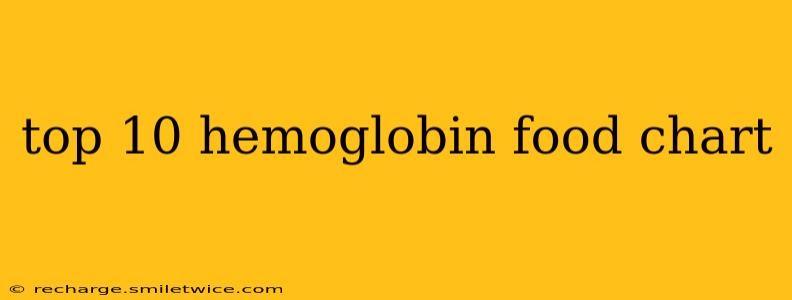Maintaining healthy hemoglobin levels is crucial for overall well-being, as hemoglobin is the protein in red blood cells responsible for carrying oxygen throughout the body. Low hemoglobin, or anemia, can lead to fatigue, weakness, and other health problems. While medical advice should always be sought for diagnosis and treatment of anemia, dietary changes can significantly contribute to boosting hemoglobin levels naturally. This guide provides a comprehensive chart of the top 10 hemoglobin-boosting foods and explores frequently asked questions surrounding this important topic.
Top 10 Hemoglobin-Boosting Foods Chart:
| Rank | Food | Key Nutrient(s) | Benefits | Serving Suggestion |
|---|---|---|---|---|
| 1 | Spinach | Iron, Folate, Vitamin C | Excellent source of iron, aids iron absorption | Add to salads, smoothies, or sauté as a side dish |
| 2 | Red Meat (Beef, Lamb) | Heme Iron | Highly bioavailable form of iron | Lean cuts are preferable; consume in moderation |
| 3 | Lentils | Iron, Folate, Protein | Great source of plant-based iron | Add to soups, stews, or salads |
| 4 | Beetroot | Nitrates | Improves blood flow and oxygen delivery | Roasted, juiced, or added to salads |
| 5 | Chickpeas | Iron, Folate, Protein | Excellent plant-based source of iron | Hummus, salads, or roasted |
| 6 | Kidney Beans | Iron, Folate, Protein | Another great plant-based iron source | Soups, stews, or as a side dish |
| 7 | Dried Apricots | Iron | Convenient and concentrated source of iron | Snack on a handful or add to trail mix |
| 8 | Dark Leafy Greens (Kale) | Iron, Vitamin K, Folate | Supports overall blood health | Smoothies, salads, or sautéed |
| 9 | Tofu | Iron | Good source of plant-based iron | Stir-fries, tofu scramble, or added to salads |
| 10 | Fortified Cereals | Iron, Folate | Convenient way to increase iron intake | Check labels for iron content |
Frequently Asked Questions (FAQs)
This section addresses common questions people have about improving hemoglobin levels through diet.
What are the best foods to increase hemoglobin quickly?
While no food will instantly boost hemoglobin, foods rich in heme iron (from animal sources) are generally absorbed more efficiently than non-heme iron (from plant sources). Red meat and organ meats are excellent examples of heme iron sources. However, a balanced diet incorporating both heme and non-heme iron sources, along with foods rich in Vitamin C to enhance absorption, is most effective for long-term improvements.
What foods are high in iron for vegetarians?
Vegetarians and vegans can obtain iron from various plant-based sources, including lentils, chickpeas, kidney beans, spinach, tofu, and fortified cereals. Pairing these iron-rich foods with Vitamin C-rich foods like citrus fruits or bell peppers enhances iron absorption.
What vitamins help increase hemoglobin?
Vitamin C plays a crucial role in improving iron absorption. Folate (Vitamin B9) and Vitamin B12 are also essential for red blood cell production. A deficiency in any of these vitamins can negatively impact hemoglobin levels. Consulting a doctor or registered dietitian can help determine if vitamin supplementation is necessary.
What is the best way to increase hemoglobin naturally?
A holistic approach is best. This includes consuming a balanced diet rich in iron, folate, vitamin B12, and vitamin C. Regular exercise, sufficient hydration, and managing underlying health conditions are also crucial. Consult a healthcare professional for personalized advice and to rule out any underlying medical causes for low hemoglobin.
Which fruits are good for increasing hemoglobin?
While not direct sources of iron, fruits rich in Vitamin C, such as oranges, lemons, grapefruits, and strawberries, significantly enhance the absorption of iron from other foods. Dried apricots are also a good source of iron itself.
This comprehensive guide provides valuable information on boosting hemoglobin levels through dietary choices. Remember, this information is for educational purposes only, and consulting with a healthcare professional is vital for diagnosis and personalized treatment plans. Maintaining a healthy diet and lifestyle significantly contributes to overall well-being, including maintaining healthy hemoglobin levels.
